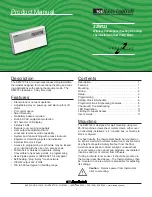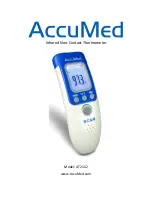
R
2800 LAURA LANE • MIDDLETON, WI 53562 • (800) 288-9383 • FAX (608) 836-9044 • www.tcsbasys.com
8
timer. If each occupancy period is about the same length
of time, (theaters, meetings) another option is to set the
DI3 to external override, and use the timed override but-
ton to put the unit in occupied mode. (This function uses
a virtual DI, see Note on page 6 for details.)
To make the unit always occupied, set DI3 to external
time clock and short the DI3 terminal to ground. (This
function uses a virtual DI, see Note on page 6 for details.)
DiSChArge Air temPerAture SenSing
The SZW123 accepts a remote discharge air sensor for
monitoring purposes. (See setup instructions for dipswitch
placement for this option.)
Choose YES in programming screen #27 only if you are
using a discharge air sensor and you want to enable the
discharge air temperature high and low limit functions. If
NO is chosen, the discharge air will still be monitored.
When the function is enabled, a HIGH LIMIT and LOW
LIMIT are entered in steps #29 and #28. If the HIGH
LIMIT is reached, the fan and heating stages will be
turned off and will remain off until the discharge air tem-
perature falls 3° below that limit. If the LOW LIMIT is
reached, the fan and cooling stages will be turned off and
will remain off until the discharge air rises 3° above that
limit. When either limit is reached, the service LED will be
on until normal operation resumes.
The discharge air span is 0°F to 150°F (-17.8°C to
65.6°C).
outDoor Air temPerAture SenSing
The SZW123 accepts a remote 1000
Ω
outdoor tempera-
ture sensor for monitoring purposes. (See setup instruc-
tions for dipswitch placement for this option.)
Choose YES in programming screen #30 only if you are
using an outdoor air sensor and you want to enable the
outdoor air heating and cooling lockout functions. If NO is
chosen, the outdoor air will still be monitored.
When the function is enabled, a COOLING LOCKOUT
TEMP and HEATING LOCKOUT TEMP are entered in
steps #31 and #32. If the outdoor temperature falls below
the COOLING LOCKOUT TEMP, all cooling stages will
be locked out and will remain locked out until the outdoor
air temperature rises 2° above the lockout temperature.
If the outdoor temperature rises above the HEATING
LOCKOUT TEMP, all heating stages will be locked out
and will remain locked out until the outdoor air tempera-
ture falls 2° below the lockout temperature.
The outdoor air span is -40°F to 160°F (-40.0°C to
71.1°C).
FAn ProVing
The SZ1009 allows DI1 to be set for fan proving to pro-
tect equipment on fan failure. To utilize this function, input
a pressure or current switch which tells when the fan is
running. If the thermostat closes its fan contact, and the
DI1 is not closed after thirty seconds, the system will go
to OFF, disabling all outputs, the fan LED will turn off, and
the service LED will be lit until the system is manually
reset by switching the system to a mode other than OFF.
(This function uses a virtual DI, see Note on page 6 for
details.)
Di2 SetPoint ShiFt
The SZ1009 allows DI2 to be set for setpoint shift for
energy demand setback. This is enabled by setting DI2
to the MONITOR mode. A digital contact that closes
when setback is needed should be wired into DI2. You
may specify a number of degrees such that, when the
thermostat is operating in the occupied mode, and DI2
is closed, the heating setpoint will be lowered this num-
ber of degrees, and the cooling setpoint will be raised
this number of degrees. The fan will continue to operate
according to its occupied setting. If you are using DI2 as
monitor for another purpose, make sure to set this value
to zero. (This function uses a virtual DI, see Note on
page 6 for details.)
StAge outPut PArAmeterS
For each stage of heating and cooling, you may specify
an offset and a differential value. This allows you to
adjust the operation of the thermostat to fit your equip-
ment to the building load. The offset value is the amount
away from the setpoint a stage will turn off. By assign-
ing a stage a value other than zero, you “anticipate”
that the residual heat or cooling in the duct or the other
stages will bring the temperature back to setpoint. In
most cases, the first stage is set to zero. The differential
value is the difference between the on and off points.
This value depends on the load and on the equipment
size. If the equipment is large for the load, you may want
to make this value as high as 5 to prevent equipment
cycling. If the equipment is small compared to the load,
or if tight control is desired, you may want to make this
value as low as 1.
The fact that the stages are configurable allows unused
stages to be set to activate physical alarms if desired.
heat Setpoint
Cool Setpoint
on
on
on
on
oFF
oFF
oFF
oFF
Differential
Differential
offset
offset
Differential
Differential
In summary, unlike most other multi-stage program-
mable thermostats, the Superstat allows independent
adjustments of “offsets” and “differentials” for stages of
heating and cooling. The offset settings can be viewed
as setpoints for the second and third stages and are
programmed in the Superstat in the number of degrees
(i.e. 1,2,3 ... ) beyond the heating and cooling setpoints
(temperatures to be maintained).































